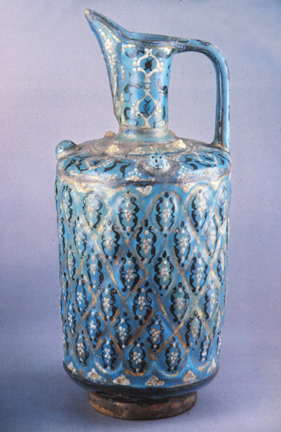The production of lusterware was a difficult and exacting process, and as a result, few cities produced it, such as Basra (Iraq), Raqqa (Syria) and especially, Kashan (Iran). A variation of the lusterware technique that was used in Kashan was what is called lajvardina. In this process, a copper based turquoise glaze is used on the fritware body. It is on this turquoise glaze that the overglaze lusters are applied and fired, in the manner described for the last image. Lajvardina was very desirable, and exported to Egypt, North Africa, and Spain. This ewer form is clearly influenced by metal shapes. Surface design is dense and intricate in Kashan lusterware, making the work appear quite different from the subtlety of Chinese Song ceramics. The porcelain of Song China was nevertheless influential during this period primarily by causing Islamic potters to develop the white fritware body. Here that white fritware body can be seen providing a translucent backdrop for the delicate turquoise glaze. The shape of the vessel also has the strength and purity of Song ceramics.

Lajvardina Ewer from Kashan, Luster, 1210 CE


